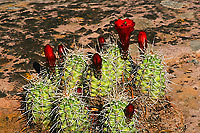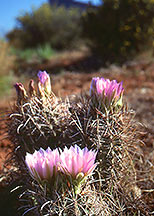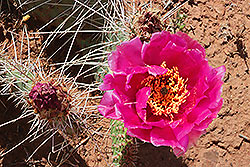Desert Cacti |
|
Cacti are synonymous with desert environments. Leafless, spine covered, and drought tolerant, these succulents are the classic desert plant. The plants seem to endure the seasons, expanding slightly or growing slowly when conditions are favorable, retracting within themselves or dropping off excess pads when survival is at stake. Perhaps the best-known cactus is the saguaro, the tree-sized, multi-armed species that grows in the Sonoran Desert of Arizona, Sonoran state of Mexico, and parts of California. Often depicted with a buzzard perched on top of its spiny head patiently awaiting the demise of some unfortunate soul crawling past looking for water, this species is the Arizona state wildflower, a tribute to its gorgeous blossom and hardy character. Saguaros don’t occur in southern Utah’s Canyon Country, but fortunately many other species of cacti exist here.
Like most cacti, the claret cup and others have a waxy coating over their pads to prevent moisture loss to the dry desert air. The pads contain chlorophyll which drives photosynthesis since they don’t have leaves. Cacti also have a unique photosynthetic pathway called CAM or Crassulacean Acid Metabolism which enables them to fix carbon with minimal moisture loss. Whipple’s fishhook cactus (Sclerocactus whipplei) is a barrel-shaped cactus that grows in Utah. More pint-sized than barrel, this cactus bears fishhook-shaped spines and light purple flowers. The common name honors Amiel Wicks Whipple (1818-1863), a topographical engineer who led the Pacific Railroad Survey along the 35th Parallel. He also was involved on the boundary survey between the US and Mexico from 1853-1856.
At higher elevations, one might encounter Simpson’s footcactus (Pediocactus simpsonii) which is a small, hemispherical cactus with whitish flowers. Another topographical engineer, James H. Simpson (1813-1883) first collected this species for science in Nevada. Another adaptation that cacti have to survive in the desert is a series of shallow roots that spread laterally just beneath the soil surface. These roots allow the plant to quickly absorb moisture after a rainstorm, rather than having a deep taproot, a good idea when trying to survive in a desert environment.
|


 One of the earliest blooming species is the claret cup cactus (Echinocereus triglochidatus). Low growing and clump-forming, these cacti produce brilliant scarlet-colored flowers in April and May which attract hummingbirds as pollinators. Echinocereus means “like a hedgehog” referring to the cacti’s shape and spiny appearance. Triglochidatus means “three barbed bristles” and refers to the straight spines which radiate out from a central point often growing in clusters of three. At times the plants grow in clumps that may reach 3-4ʹ in diameter – these are the ones you’ll want to GPS to revisit again.
One of the earliest blooming species is the claret cup cactus (Echinocereus triglochidatus). Low growing and clump-forming, these cacti produce brilliant scarlet-colored flowers in April and May which attract hummingbirds as pollinators. Echinocereus means “like a hedgehog” referring to the cacti’s shape and spiny appearance. Triglochidatus means “three barbed bristles” and refers to the straight spines which radiate out from a central point often growing in clusters of three. At times the plants grow in clumps that may reach 3-4ʹ in diameter – these are the ones you’ll want to GPS to revisit again. There are several species of prickly pear cactus (Opuntia sp.), with flattened pads joined together and prickly reddish fruits, that are found in the area. These plants often grow in profusion where there has been extensive grazing. Though cattle avoid the cacti, you might see where a woodrat has been chewing on a pad. And don’t forget to look inside the flower as there may be several different beetle or bee species wandering about amongst the forest of stamens collecting pollen.
There are several species of prickly pear cactus (Opuntia sp.), with flattened pads joined together and prickly reddish fruits, that are found in the area. These plants often grow in profusion where there has been extensive grazing. Though cattle avoid the cacti, you might see where a woodrat has been chewing on a pad. And don’t forget to look inside the flower as there may be several different beetle or bee species wandering about amongst the forest of stamens collecting pollen.